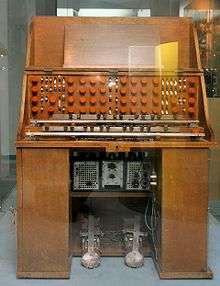Oskar Sala
Oskar Sala (18 July 1910 – 26 February 2002) was a 20th-century German physicist, composer and a pioneer of electronic music born in Greiz.[1] He played an instrument called the Trautonium, a predecessor to the synthesizer.[2]
Studies
Sala studied piano and organ during his youth, performing classical piano concerts as a teenager. In 1929, he moved to Berlin to study piano and composition with composer and violist Paul Hindemith at the Berlin conservatory. He also followed the experiments of Dr. Friedrich Trautwein, at the school’s laboratory, learning to play with Trautwein's pioneer electronic instrument, the Trautonium.[1]
On 20 June 1930 Sala and Paul Hindemith gave a public performance at the Berliner Musikhochschule Hall called “Neue Musik Berlin 1930″ to introduce the Trautonium. Later Sala toured Germany with the Trautonium; in 1931 he was the soloist in a performance of Hindemith's Concert for Trautonium with String Quartet.[1] He also soloed in the debut of Hindemith student Harald Genzmer's “Concert for Trautonium AND Orchestra”.[3]
Sala studied physics at the University of Berlin between 1932 and 1935. He helped to develop the "Volkstrautonium",[4] a Trautonium that Telefunken hoped to popularize. In 1935 he built a "Radio-Trautonium", and in 1938 a portable model, the "Konzerttrautonium".[1][5]
Mixtur-Trautonium

In 1948 Sala further developed the Trautonium into the Mixtur-Trautonium. The Mixtur-Trautonium allowed for the first time in music history the execution of sounds which had only been known in theory since the Middle Ages, but were never actually playable. Sala's invention opened the field of subharmonics, the symmetric counterpart to overtones, so that a thoroughly distinct tuning evolved.[6]
Sala presented his new instrument to the public in 1952 and would soon receive international licenses for its circuits. That same year, Harald Genzmer delivered the score to the first Concert For Mixtur-Trautonium And Grand Orchestra.[7]
In the 1950s Sala also built the Quartett-Trautonium.
Film work
In the 1940s and 1950s he worked on many film scores. In 1958 he established his own studio at Mars film GmbH (4th incarnation) in Berlin. There he produced electronic soundtracks for such films as Veit Harlan's Different from You and Me (1957), Rolf Thiele's Rosemary (1959), and Fritz Lang's Das Indische Grabmal (1959).[1]
He created the non-musical soundtrack for Alfred Hitchcock's film The Birds.[8] He received many awards for his film scores, but never an Oscar. He also did much work on German commercials, most notably one referred to as HB's little man.
He was an honorary Senator of Berlin.
Discography
- Trautonium-Konzerte
- (Wergo WER 286 266–2)
- Harald Genzmer's Konzert für Trautonium und Orchester (Concerto for Trautonium and Orchestra) (1938/39) and Konzert für Mixtur-Trautonium und großes Orchester (Concerto for Mixtur-Trautonium and Large Orchestra) (1952)
- My Fascinating Instrument
- Contains his own compositions, dating from 1955 to 1989
- Subharmonische Mixturen
- Contains Paul Hindemith's Langsames Stueck für Orchester und Rondo für Trautonium (Slow Piece for Orchestra And Rondo for Trautonium), Sala's own compositions, dating from 1992 to 1995, and his soundtrack to Der Wuerger von Schloss Dartmore (The Strangler of Castle Dartmore)
- Elektronische Impressionen
- Hindemith's 7 Triostuecke für drei Trautonien (7 Triopieces for three Trautonien), Konzertstueck fuer Trautonium und Streicher (Concertpiece for Trautonium And Strings) written in 1931 and recorded in 1977. Also contains Sala's Elektronische Impressionen (Electronic Impressions), 1978.
- Resonanzen
- (1970, re-release 1994, Originalton West OW027)
- Contains Suite für Mixtur-Trautonium und elektronisches Schlagwerk and Resonanzen: Konzertante Musik für Mixtur-Trautonium und Elektronisches Orchester.
- Effetti Sonori Musica Elettronica
- (1974, released in i-Tunes 2013, Devega)
- Miscellaneous of various electronic artists, the album contains 5 Sala's short pieces for trautonium.
Literature
- Peter Donhauser (2007). Elektrische Klangmaschinen. Boehlau Vienna (in German).
- Peter Badge (2000). Oskar Sala:Pionier der elektronischen Musik. Satzwerk, 100pp. ISBN 3-930333-34-1
- Pablo Freire / Audionautas (2011/2012). Oskar Sala. El último artesano. Parts 1234 (in Spanish)
References
- "Oskar Sala – Biography". Intuitive Music. August 16, 2003. Archived from the original on 19 July 2011. Retrieved 19 June 2010.
- Hiller, Juergen (2001–2003). "Oskar Sala". Retrieved 19 June 2010.
- "Carl Schuricht". last.fm. November 21, 2008. Retrieved 19 June 2010.
- "Trautonium Ela T 42 T42 "Volkstrautonium"" (in German). Radiomuseum.org. Retrieved 19 June 2010.
- Rainier, Chris. "The Trautonium". myspace.com. Retrieved 19 June 2010.
- Doepfer Musikelektroniks editorial staff. "DOEPFER MUSIKELEKTRONIK GMBH The Trautonium Project". analogue organisation. Archived from the original on 4 September 2011. Retrieved 19 June 2010.
A detailed technical insight into the Trautonium. - Namlook, Peter (2002). "Oskar Sala 1910–2002". Archived from the original on 22 November 2010. Retrieved 19 June 2010.
- Pinch, Trevor; Trocco, Frank (2004). Analog Days: The Invention and Impact of the Moog Synthesizer. Harvard University Press. p. 54. ISBN 0-674-01617-3.
External links
- Oskar Sala on IMDb